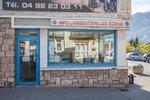THEMED PATH: The Mountain Hut path
Building, living and developing in harmony with nature! This trail highlights the possibilities for sustainable development and introduces you to a series of exemplary initiatives. An ecological trail showing that development is possible wihtout spoiling the remarkable natural heritage of the Pays des Écrins!
Description
From the car park, head towards the farm, taking the second right after the bridge. Go past the railway line and go along the edge of the farm and then follow the Durance.
- Continue uphill until you come to the railway line and follow it. At the panel at the Pont de Chirouze, continue by taking the uphill path on the right.
- When you come to the D4, turn right and follow it for a few metres.
- Keep an eye out for the path on the left; head towards Prelles.
- Take the D4 for a short distance; fork onto the path on the left to reach Prelles. In Prelles, turn left opposite the church to return to your starting point.
- Departure : D4, Prelles
- Arrival : D4, Prelles
- Towns crossed : Saint-Martin-de-Queyrières
Altimetric profile
Recommandations
Note, be alert: in places, the trail runs along the banks of the Durance and alongside the railway line.
Information panels are installed around the circuit.
Check weather conditions before setting off.
Rescue services contact details: Secours Montagne (Mountain Rescue): +33 (0)4 92 22 22 22 or 112
Show consideration for the work of farmers, livestock keepers and owners
Close all gates behind you
Take your litter home
Do not take shortcuts across pastureland
Information desks
23 Avenue de la République, 05120 L'Argentière-La Bessée
Vallouise Park house
, 05290 Vallouise
Information, documentation, models, exhibitions, screenings, product sales and works of the Park. Guided tours for school, reservation required. The new Park House opened in Vallouise since June 1, and offers visitors an interactive permanent exhibition inviting to explore the area and its heritage. A temporary exhibition space will allow a renewed offer. Finally, the device is completed by an audiovisual room to organize screenings and conferences Free admission. All animations of the Park are free unless otherwise stated.
Transport
Public transport >> www.pacamobilite.fr
Consider car-sharing >> www.blablacar.fr
For more information, ask at the Tourist Information Office nearest to the trail starting point.
Access and parking
8.8 km from L'Argentière-La Bessée, take the N94.
Parking :
7 points of interest
 Pastoralism
PastoralismHigh-mountain farming
The mountains are areas naturally used for agriculture. These agricultural practices have been carefully thought-out in order to protect the environment. Agri-environmental measures have been introduced. They are designed to encourage and remunerate volunteer users of mountain spaces in their actions to protect natural environments. These measures prevent over-grazing, the invasion of bushes and shrubs and the proliferation of invasive plants.
 Pastoralism
PastoralismStraw insulation
Straw can be used as an insulation material. In fact, it can even be used in its natural state to insulate walls. Straw is available everywhere, it is an abundant resource and its production creates no pollution so it makes a very eco-friendly material. In addition, it offers excellent sound insulation.
 Water
WaterThe adoux, the nurseries of our rivers
Adoux are water courses in which fish can rest, breed and grow within a remarkable ecological reservoir. An ecological reservoir is an area which contains all the natural habitats necessary for the life cycle of a species: from reproduction to feeding and growth. So it could be said that an ecological reservoir assures the survival of the species and fulfils the function of a breeding ground.
 Know-how
Know-howThe Resourcerie
This former school has acquired a new function: that of giving new life to obsolete furniture and objects. The Resourcerie reclamation and repurposing centre makes new objects out of other, unwanted items. No new raw materials are used in their production, thereby helping to prevent the accumulation of waste. Eco-friendly and sustainable, the reclamation and repurposing centre reduces waste and creates employment.
 Know-how
Know-howThe eco-constructed school
The school in Saint-Martin-de-Queyrières is built out of materials that are safe and sustainable. The building is of bioclimatic design, that is to say, the architecture is adapted to the characteristics of the climate of the local area in which it is sited, in order to obtain the most natural ambient comfort possible. The environment provides power and resources through, for example, the capture of solar energy, the use of air circulation techniques, rainwater harvesting etc.
 Know-how
Know-howEco-construction
On this path, you will pass by some eco-constructed cabins. One of them is made from larch, a wood that is naturally resistant to bad weather and insects and needs no previous treatment. The other is constructed according to the “post-beam” principle, which is reminiscent of half-timbered construction. This is characterised by an exposed supporting framework. The beams support the roof, and these beams are in turn are supported by the posts.
 Fauna
FaunaThe larch, a tree unlike any other
The symbol of the Southern Alps, this softwood tree loses its leaves in winter, and is swathed with gold and lights up the mountains in autumn. The larch forests are maintained by the grazing of flocks. Without them, other trees like the fir or other pine trees could grow, creating a different kind of forest. A pioneer species, the larch establishes freely in light conditions. Its solid rot-proof wood has always been used in the construction of houses.
Source

Report a problem or an error
If you have found an error on this page or if you have noticed any problems during your hike, please report them to us here:


